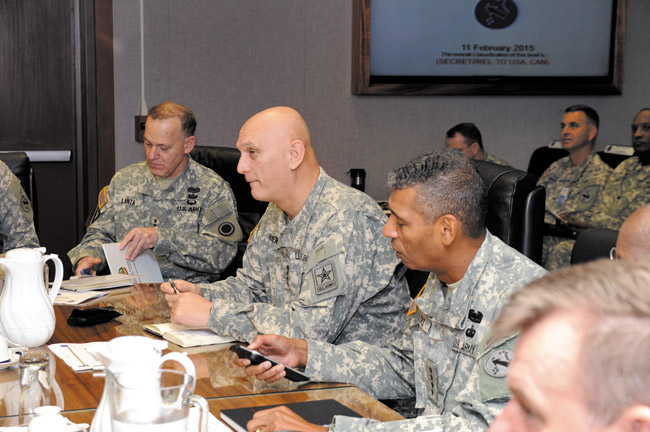Where’s The Military Rebalance?

Gen. Raymond T. Odierno (center), chief of staff of the Army, and Gen. Vincent K. Brooks (right), U.S. Army Pacific commanding general, sit together during a brief at USARPAC headquarters SGT. JORGE HIGUERA/U.S. ARMY PUBLIC AFFAIRS PHOTO
U.S. Army Chief of Staff Gen. Ray Odierno came visiting recently. He devoted his time in the Islands to a general’s normal pursuits: reviewing the troops and praising their readiness to respond to threats to the security of the country.
But this Hawaii sojourn included a more delicate, more diplomatic task: calming the nerves of both the soldiers in the Hawaii garrison and the Island community that serves them.
With the ending of the U.S. combat role in Iraq and Afghanistan, the Department of Defense announced in 2012 a “right-sizing” of U.S. forces. “Right-sizing,” of course, is another marvelous governmental euphemism for slashing numbers and saving money — or, more likely, redirecting it to the development and purchase of ever-fancier, ever-more-expensive weapons systems.
Across the force, the proposed cuts would mean 120,000 fewer soldiers (from a wartime high of 570,000 to 450,000) and 20,000 fewer Marines (from 202,000 to 182,000).
With the announcement of cuts of any size in military personnel, communities dependent on military spending across the country shudder. Hawaii, with its lack of economic diversity (tourism, construction, a little agriculture and the military), experiences a statewide quake.
Its geological center can be found on Oahu, at Schofield Barracks, the home of the Army’s 25th Division and one of the nation’s largest military installations. Recent talk has been of the loss of the division and the consequent dismantling of the economic engine of Central Oahu.
“Whoa!” said Odierno in effect. He characterized the cuts on Oahu as possibly “very small.” As William Cole reported in Honolulu Star-Advertiser, Odierno could offer nothing definite, “I don’t know yet … Here’s what I would say: Our defense strategy is to rebalance toward the Pacific, so we do take that into consideration as we make our decisions. … we understand that Hawaii is an important part of our defense strategy.”
Its importance lies in the size of the Pacific Ocean, which presents what Odierno called “daunting” distances. “We have soldiers on the Korean Peninsula, we have some in Japan, but the soldiers here in Hawaii really significantly reduce that distance. And so having capability here is essential to our success in the future.”
The “rebalance” of forces toward the Pacific is the “pivot” spoken of so frequently in recent Hawaii congressional and senatorial campaigns. In 2012 and 2014 election contests, various candidates suggested that pivot to face China and India, the world’s two demographically and economically exploding world economies, would enhance the importance of Hawaii and benefit its economy.
But in light of peace breaking out (at least for the U.S. in Iraq and Afghanistan) and the concomitant cuts in the nation’s forces, Odierno’s comments indicate rebalance only will slow the departure of troops from Hawaii.
Add to that the threat heard from a couple of 2016 presidential aspirants that they would put troops back on the ground in the Middle East. Needless to say, that would spell a Middle Eastern, not a Pacific, rebalance. Or perhaps it should be called a re-rebalance.
The Army currently keeps 22,500 soldiers in Hawaii. They eat here, recreate here, study here, raise children here, protect us and much, much more. They, with their cousins in the Marine Corps, Navy and Air Force, contribute in the neighborhood of $12 billion to Hawaii’s economy.
Odierno’s words soothed, if only slightly, only hauntingly.
dbboylan70@gmail.com





